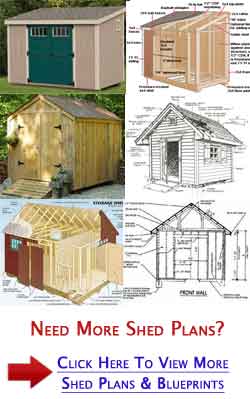

 barbaraiweins.com
barbaraiweins.com Opening: Shedding Light on DIY Storage Sheds So, you need extra storage space? Building your own shed can be a rewarding and cost-effective solution. This guide will walk you through the process of constructing a simple, functional storage shed, step by step. Get ready to put on your DIY hat!
Step 1: Planning and Preparation Before you start swinging a hammer, careful planning is essential.
- 1.1 Determine the size and location: Measure the space where you want to build your shed. Consider local building codes and setback requirements. Think about what you'll be storing and the size needed to accommodate those items.
- 1.2 Obtain permits (if required): Check with your local building department to see if you need a permit for a shed of your desired size and location. It's better to be safe than sorry.
- 1.3 Design your shed: Create a basic sketch of your shed. Include dimensions, door and window placement (if desired), and roof type. This doesn't have to be professional, but it should give you a clear visual of the final product. You can find free shed plans online if you're not comfortable designing your own.
- 1.4 Gather materials and tools: Create a materials list based on your design. Common materials include lumber (treated for ground contact for the base), plywood or OSB for walls and roof, roofing materials (shingles, metal, etc.), siding (optional, depending on your aesthetic), fasteners (nails, screws), a door, and any windows you plan to install. Essential tools include a circular saw, drill, level, measuring tape, hammer, safety glasses, and work gloves.
Step 2: Building the Foundation A solid foundation is crucial for a long-lasting shed. We'll use a simple gravel pad foundation for this example.
- 2.1 Clear and level the area: Remove any vegetation, rocks, and debris from the area where you'll be building the shed. Use a shovel and level to create a level surface.
- 2.2 Create a gravel base: Spread a layer of crushed gravel (4-6 inches thick) over the leveled area. Compact the gravel with a hand tamper or plate compactor. This provides drainage and prevents the wood from directly contacting the ground.
- 2.3 (Optional) Build a wooden frame: You can build a rectangular frame using treated lumber that sits on top of the gravel. This frame adds extra stability and keeps the shed floor slightly elevated. Secure the corners of the frame with screws or nails. Make sure the frame is level.
Step 3: Framing the Walls The walls provide the shed's structure and support the roof.
- 3.1 Cut the wall studs: Based on your shed height, cut the wall studs to the desired length. Use a circular saw to ensure accurate cuts.
- 3.2 Assemble the wall frames: Lay out the studs on a flat surface and attach the top and bottom plates (horizontal pieces of lumber) to the studs using nails or screws. Space the studs 16 inches apart on center.
- 3.3 Frame the door opening: Include extra studs and a header (a horizontal piece above the door) to frame the door opening.
- 3.4 Raise and secure the walls: With a helper, raise each wall frame into position. Use temporary braces to hold the walls upright. Ensure the walls are plumb (vertical) and square (corners are 90 degrees). Secure the walls to the foundation (or wooden frame, if you built one) using screws or nails.
- 3.5 Sheathe the walls: Cover the exterior of the wall frames with plywood or OSB sheathing. This adds strength and rigidity to the walls. Attach the sheathing to the studs using nails or screws.
Step 4: Building the Roof The roof protects the shed from the elements. We'll build a simple gable roof (two sloping sides).
- 4.1 Build the rafters: Cut the rafters to the correct length and angle for your desired roof pitch. You can use a rafter square or online calculators to determine the correct angles.
- 4.2 Attach the rafters: Secure the rafters to the top plates of the walls, creating a triangular shape. Use nails or screws. Ensure the rafters are evenly spaced and aligned.
- 4.3 Add the ridge board: Attach a ridge board (a horizontal piece of lumber) along the peak of the roof, connecting the tops of the rafters.
- 4.4 Sheathe the roof: Cover the rafters with plywood or OSB sheathing. Attach the sheathing to the rafters using nails or screws.
- 4.5 Install roofing materials: Cover the roof sheathing with roofing felt (underlayment) to provide a waterproof barrier. Then, install your chosen roofing material (shingles, metal, etc.) according to the manufacturer's instructions.
Step 5: Installing the Door and Finishing Touches Now it's time to make the shed functional and aesthetically pleasing.
- 5.1 Install the door: Hinge the door to the door frame and install the necessary hardware (latch, handle, etc.). Ensure the door swings smoothly and closes securely.
- 5.2 Add siding (optional): If desired, install siding to the exterior walls. This adds aesthetic appeal and provides additional protection.
- 5.3 Add windows (optional): Cut openings in the walls and install windows.
- 5.4 Caulk and seal: Caulk and seal any gaps or cracks around the door, windows, and roof to prevent water intrusion.
- 5.5 Paint or stain (optional): Paint or stain the shed to protect the wood and enhance its appearance.
- 5.6 Add shelving or organization: Install shelves, hooks, or other organizational systems to maximize storage space inside the shed.
Conclusion: Your DIY Shed is Complete! Congratulations! You've successfully built your own storage shed. Now you have a functional and organized space to store your tools, equipment, and other belongings. Enjoy your new DIY shed! Remember to maintain your shed regularly to ensure it lasts for years to come.
A Comprehensive Guide On Warehouse Storage
 barbaraiweins.com
barbaraiweins.com Choosing The Right Storage
 www.lynns.com.au
www.lynns.com.au The 14 Best Storage Units In Toronto [2022]
![The 14 best storage units in toronto [2022]](https://i0.wp.com/torontoblogs.ca/wp-content/uploads/2022/04/surface-image-cart-with-cardboard-boxes-empty-hall-self-storage-facility-copy-space.jpg) torontoblogs.ca
torontoblogs.ca


0 komentar:
Posting Komentar